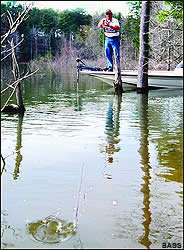
You can't pigeonhole Mark Kile. Though this two time CITGO Bassmaster Classic qualifier is skilled in the light-line methods he learned in his home state of Arizona, he's equally comfortable fishing thin, murky water, with a flippin' stick and heavy string.
That may be why Kile readily modifies finesse tactics to make them work in shallow water. He was way ahead of the curve when it came to flippin' and pitchin' tubes with heavy tackle, and it's no surprise that he's fishing drop shot rigs in places where bass normally don't see them.
"Drop shotting really comes through for me when I'm casting for bass that are getting a lot of fishing pressure," Kile says.
Shallow creek channels
Creek channels that meander through shallow flats or sweep away from channel banks often hold bass in the spring and fall. Most anglers pick off, with crankbaits, spinnerbaits and bottom-hopping lures, the easy fish that hang on the lips of channels. Kile nabs the reticent bass by probing the bottom of the channel with a drop shot rig and a straight, slender 4- to 6-inch worm. In clear water, he also cleans up with a Tiki-Drop from Wave Worms, a 3 1/2-inch finesse reaper.
"Bass follow those channels like roads," Kile says. "It may be only 2 feet deep on the edge of the channel and 5 feet deep on the bottom of it."
If snags aren't an issue, Kile drop shots with 6- or 8-pound McCoy Mean Green line in clear or stained water. The reason he goes with light line has little to do with visibility. It is because light line lets his baits work with more lifelike action than with heavy lines.
Kile's basic light-line rig consists of a 3/16-ounce drop shot weight about 7 inches beneath a No. 2 Gamakatsu light wire EWG hook. He claims the small hook gives his baits more action, and easily penetrates a bass' mouth.
"When you set the hook with that little Gamakatsu, that bass is yours," Kile says.
Shallow docks
Kile also fishes shallow docks with a light drop shot rig, regardless of the water color. The one adjustment he makes for docks is downsizing from a 7-foot spinning rod to a 6-foot, 6-inch stick that delivers better accuracy.
"It's hard to skip a drop shot rig, but you can pitch it into nooks and crannies with a spinning rod," Kile says. "I can go right behind somebody fishing a jig or worm and smoke the bass with a drop shot."
Kile "spot fishes" when casting a drop shot rig around docks. He pitches to a corner, a piling or some other portion of the dock that may hold a bass, and lets the drop shot rig sink to the bottom. Then he gives the line a little slack and shakes the bait in place. He may let the bait sink to the bottom and pick it back up, but he never moves the weight. If he is unable to draw a strike, Kile retrieves the bait and pitches it to the next spot on the dock (or pulls the bait quickly to the next spot) and gives the bait a repeat performance.
"The biggest mistake I see with guys fishing a drop shot is that they try to hop it over the bottom like a Texas rig or drag it like a Carolina rig," Kile says. "They get creamed by other drop shot fishermen, and they can't understand why."
Flippin' and pitchin'
Kile trades his spinning tackle for a 7-foot, 11-inch Rogue flippin' rod when he drop shots heavy cover. He matches the rod with 20-pound line and whatever size weight is necessary to penetrate the cover, from 1/4 ounce to 1 1/2 ounces. His money bait is a 4-inch tube rigged on a 5/0 Gamakatsu EWG hook. Here again, he keeps the distance between the bait and the drop shot weight short, typically 7 or 8 inches.
"I see a lot of guys flippin' a drop shot rig with a long line between the bait and the weight," Kile says. "I think that's a mistake. Bass in shallow cover stay close to the bottom. A short leader gives you that subtle drop shot action down where a bass is most likely to see it."
When he is punching through matted grass, Kile replaces the drop shot weight with a Texas rigged Tiki 3-inch Grass-Craw. Bass often engulf the streamlined craw the instant it slips through the grass, so the drop shot bait above it may not have an opportunity to reach the bottom.
Bedding bass
Kile also goes with a flippin' rod, a tube, and 20-pound line when he drop shots for bedding bass. He doesn't believe the heavy line puts bass off, even in clear water. He prefers a 1/2-ounce drop shot weight for bed fishing, and cuts the leader down to 4 or 5 inches. The heavy weight stays put when Kile dances the tube aggressively, while the short leader keeps the tube close to the bed, where it drives bass mad.
"I stick mostly with crawfish colors when I fish for bedding bass," Kile says. "Bright colors, like white and chartreuse, are easier for fishermen to see, but I think bass hit natural colors faster than something bright."





